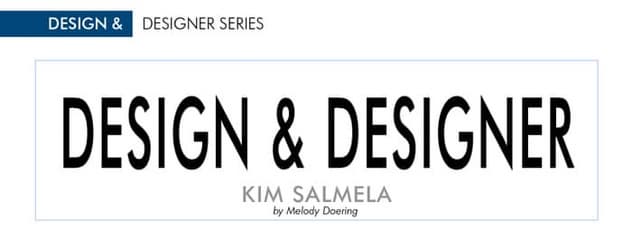
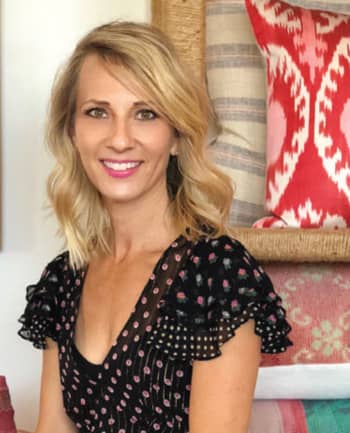
Kim Salmela doesn't believe that people should furnish their homes by making safe decisions. She says, "There are no rules. That's the rule!"
For this issue of Furniture World we interviewed multi-faceted designer, entrepreneur, and manufacturer Kim Salmela. Kim got her start in design as the creative director for the entertainer Prince. From that unconventional beginning she went on to develop award-winning retail stores, become a sought after interior designer and create branded product lines. Her extensive world travels provide inspiration for her design palette, which is a bold mix of colors, patterns, and styles that create joyous interiors.
We can’t start a conversation with you at any other point than with your design work for Prince. How did that come about?
“My junior year of college was spent in Milan. There the modern influence of my childhood was challenged by exposure to European cities. I saw homes and apartments where old was mixed with new. What might be called my ‘design philosophy’ came into focus. I returned home and finished a double major in international relations and foreign studies.
“Then after graduating from the University of Minnesota, I landed a dream job. My friend, who was a backup dancer for the singer Prince, overheard that he planned to open a restaurant and nightclub. She suggested that I meet with Prince to share some of my ideas.
“I was 21 years old with no design background. Why would he even talk to me? My friend said, ‘I know the woman in charge, she’s not creative, and you have so many great ideas.’ So she got me an interview; I drove out to Paisley Park Studios and was hired to work on the project.
“Long story short, they ended up keeping me on as creative director doing set and costume designs. I organized social events for Prince and mini-concerts. At 21, it seemed like the best job in the world.”
Restaurateur to Designer
How did you move from working with Prince’s organization into design?
“Along with some friends, we adapted Prince's idea to open a hot-spot restaurant and nightclub in downtown Minneapolis.
“Soon after, I felt I needed to set out on a ‘real’ career path, and opened a retail furnishings store. My first store, Restoration, presented a mix of old and new furnishings. I’d go to estate sales, flea markets, antique and gift shows to find creative, cool products. Each room in the store had its own theme. People would come in and say, ‘Oh my gosh, I love the feel of this.’ Then they would ask me to decorate their homes. I started doing interior design.
“The store's name was changed from Restoration to Paris Flea Market. Two years later a second store was added, Belle Epoque, focused more on furniture and interior design. Eventually I expanded to a larger space called Alfred’s Grand Petit Magasin.
“That snowballed into a big business. I flew to France, rented a truck, and drove around the country, shipping back containers of antiques. At that point, head buyers from big national chains shopped my store in Minneapolis to buy those antiques to knock off for their catalogs.”
Creating a Retail Destination
“Minneapolis is a big retail market. There are a lot of vendors, designers and people from the retail world who visit. Still, it was surprising that my little store in the middle of Minneapolis became known internationally. Alfred's Grand Petit Magasin featured a cafe, gifts, antiques, new furniture and clothing. There were vintage things and one-off items that could all be mixed together. And, these items could not be found anywhere else! It was this lifestyle offering that enticed people to spend half a day there browsing and shopping.
“A top way to become a stronger retailer is to become a destination for items customers can't find anywhere else. Everything's shoppable online, so how can most retailers compete for people who are internet-price shopping? It’s the same, or even harder, for interior designers. It has become more challenging and more urgent for retailers and designers to offer their clients unique products to stay ahead of the game.
“My stores were always super experiential. Every room setting told a story. There are a lot of stores that display a sofa, a coffee table, and a chair that kind of match. And, at the other end of the store is the pillow section.
“Instead, I prefer to tell a lifestyle story, mix it all up. Consumers have a hard time imagining their rooms, so they need visual inspiration. I don't see many stores that do it really well. It’s an opportunity, a way to become unique and present a showroom experience designed to make customers feel as if they are walking into a room from ‘House Beautiful’ or ‘Elle Décor’.”
Creating Sanctuary
You have been quoted as saying that people should just be able to walk into their homes and be happy. How do you go about designing to achieve that end?
“A home should be like a sanctuary, a space that is inspirational, comfortable and full of memories.
“I would love to see people take more risks with home furnishings. I want them to feel like they don’t have to buy beige because they’re worried their purchases are going to go out of style. I want them to pick a pattern and use it because they love it. People keep what they love, so yes, having clients walk into their homes and be happy is my mission, my vision, and my brand.
“I grew up with a very creative Finnish family. My parents were interested in Scandinavian design. For summer vacations they would pack the family into a van and drive around the country looking at architecture, visiting Frank Lloyd Wright's buildings and homes. When I was six or seven years old, I recall redecorating my bedroom every few months. When I got old enough to babysit, all the money I earned went towards buying furniture and accessories to design around a mood, and create an escape. Today I design the same way, by creating rooms for clients that are more about how they feel, than necessarily about how they look.”
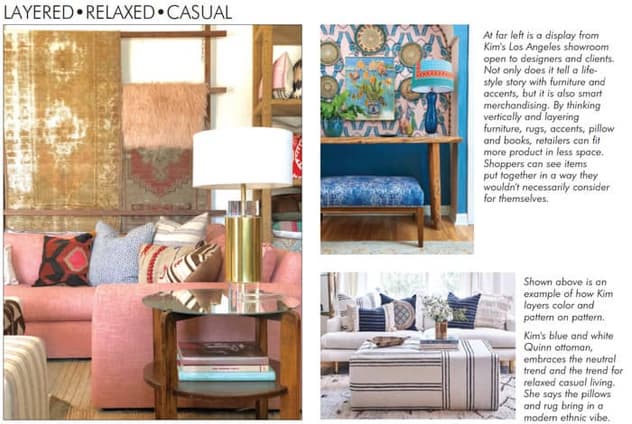
Design Process – No Rules
You’ve been quoted as saying, “There are no rules, that’s the rule!” Please explain.
“At a certain point, product trend analysis and rules for creating spaces gets in the way of trusting your taste.
“I stay away from checking the latest color trends and trust my gut. As a designer or retailer who aspires to be different, there’s a place for setting trends instead of following them.
“I use a lot of color and pattern. I don't try to compete with Restoration Hardware, or other lines that I do love, like Brownstone. Neutrals are great, but there is an opportunity for companies to use color to help customers buy furnishings they can’t find anywhere else; furnishings that create a positive mood, a happy mood.
"It has become more challenging and more urgent for retailers and designers to offer their clients unique products to stay ahead of the game."
“I constantly travel the world to find inspiring products that can be used to create a strong emotional connection. Also, to get inspiration for products I design and manufacture. I know that if I have a positive reaction to these products, there will be many other people who will feel similarly.
“That's how I pick fabrics and design frames. It has nothing to do with numbers or making safe decisions. Homes shouldn't be designed like that.”
Developing a Furniture Line
What made you decide to start designing your own furniture?
“Often, when I worked with interior design clients, I couldn’t find exactly the kinds of products I needed. In 2002, I started a line called Haute House, with a Los Angeles based business partner.
“Later I sold my interest in Haute House to my business partner and opened Alfred’s. After two years of manufacturing and continuing to run the retail store in Minneapolis, I decided to focus more on product and interior design. So, I closed up the business, and moved to LA where I opened another store working with interior design clients. “Then came a call from Judy George, the founder of the East Coast retailing chain, Domain. She had a concept she wanted to develop with a partner/designer. The concept evolved into a new furniture brand we called Hotel Maison.
“When Judy retired, I started my own line, Kim Salmela Atelier. Within the first few months, One King’s Lane saw the line and it was an incredible fit. They use me as one of their premier upholstery suppliers. We’re also one of their biggest pillow suppliers.”
Virtual vs. Brick-and-Mortar
“Online shopping has changed everything. It has broadened people's ability to seek out their own style, to find and buy what they want. At the same time, some retailers have struggled to keep up. Stores are realizing that they have to evolve from a style standpoint to compete with the internet.
“The ones that have done well obviously understand what their customers want. This is the starting point for any retailer who sets out to provide home furnishings products that appeal aesthetically to their clients.
“My style appeals to a slightly younger audience: female, 30 to 50, well-traveled, and super into fashion. They’re doing research shopping online. As an internet focused business, however, I felt I was missing a huge brick-and-mortar audience.
“So this fall, I’m launching a new line in High Point with Norwalk Furniture as my manufacturing partner. The facility, as well as the entire team, is amazing. I’m so lucky to have a relationship with Caroline Hipple and Dixon Bartlett who have mentored me throughout the years.”
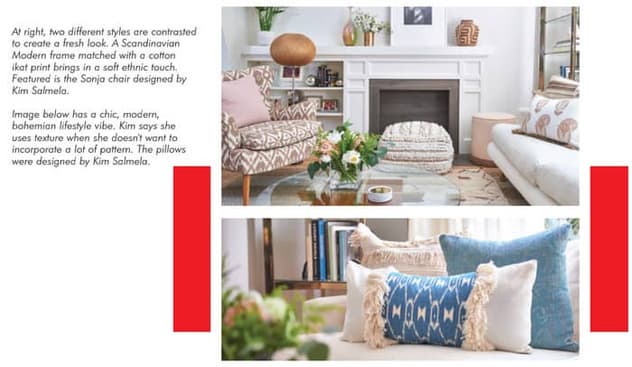
Opportunities for Furniture Retailers
What opportunities do you see in the next decade for retailers?
“If retailers can figure out and overcome the shipping/logistics issues, the internet is the way to reach millions of consumers beyond their immediate area. Every retailer must have a strong internet presence.
“I probably spend a minimum of five hours per day shopping/sourcing products online. How much easier is it for me, in my capacity as an interior designer to log on to local retailers’ sites to see what they have, versus getting into the car. When the right product at the right price pops up online, it makes it easy for customers who may never visit a store, to buy.
“European and 70s color palettes are much in use with colors like Evergreen, Vibrant Mauve, Bluish Lavenders and Pinks. Also, neutrals with ivory, black and camel as the base."
“More brick-and-mortar stores need to also take advantage of the fact that minimums for manufacturers have gone down. Being able to use the words ‘Exclusive To…’ is invaluable. All it takes is a few tweaks of a frame or to ask for exclusive colors or covers. Spending more time creating exclusive product means that retailing does not become merely a price game.”
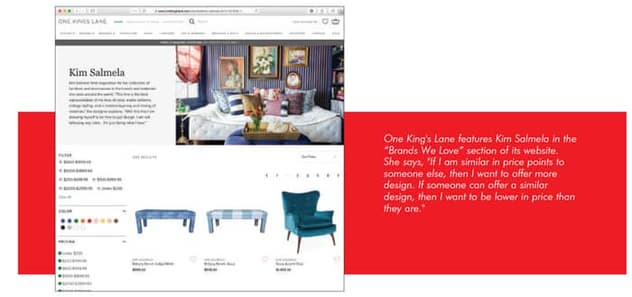
Expanding Horizons
Lots of retailers stay close to their businesses, repeating the same steps and visiting the same suppliers year after year. How can they expand their horizons and foster design innovation? How can they run a business without rules? How can they find more freedom and more success?
“First of all, retailers have to want to expand their horizons. Consider: every five to ten years they have a completely new audience and need to adapt. Retailers can stay within the same aesthetic, but should pay attention to influencers from the new generation and to what is doing well in the industry by simply logging onto one of many internet sites, like Wayfair or All Modern, and look for every item that is sold out.
“Diversity is King! The more a retailer has access to clients – has a way of actually communicating the breadth of their selection to clients – the better their chances are of making a sale. When I had my stores, I was the best sales person because I knew every line, and every product in every catalog. I also knew which vendors could make tweaks or customize products. At Alfred’s Grand Petit Magasin, shoppers would come in to purchase one item and I would end up in their homes taking measurements and doing whole houses. I never once had to do a sales pitch because my only goal was to get clients to choose the right items.
"Alfred's Grand Petit Magasin featured a cafe, gifts, antiques, new furniture and clothing. It was this lifestyle offering that enticed people to spend half a day there browsing and shopping."
“Finally, space is limited for brick-and-mortar stores. Retailers need to treat their stores like they only represent 20 percent of what they actually have access to sell. But this means training, training, training of their staff.”
Creating a Point of View
Is there value in having a story to tell, developing a point of view to differentiate oneself?
“My entire career has been about doing what isn’t already out there; seeking the one-of-a-kind; giving my clients an exclusive home that reflects their taste, not their neighbor’s. Everyone has to find their own design passion and then go for it!
“My style is not for the masses, and I am OK with that. But I also don’t claim to be unique. Others do what I do and sometimes do it better. The goal for my personal line is to offer value. If I am similar in price points to someone else, then I want to offer more design. If someone can offer a similar design, then I want to be lower in price.
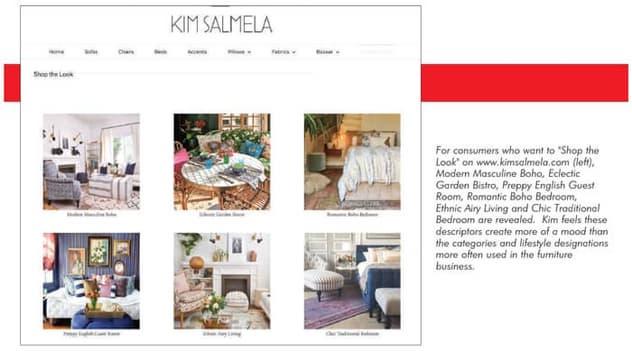
“Using social media is one way of sharing your brand story. I used to say that social media is an incredible ‘free’ advertising tool, but then I realized that it is not ‘free’ when you consider how much time it takes to develop content and maintain a consistent presence. We are all sharing bandwidth with non-designer bloggers and influencers who have a high number of followers. All that being said, social media is really critical, especially for young companies.”
Beyond Preppy English Guest Room
You have created rooms on your website with inventive names, such as: Modern Masculine Boho, Eclectic Garden Bistro, Preppy English Guest Room instead of using more pedestrian ‘bedroom’ or ‘dining room.’ Tell us about that.
“I stay away from checking the latest color trends and trust my gut. As a designer or retailer who aspires to be different, there’s a place for setting trends instead of following them."
“It all goes back to the mood you want to surround yourself with inside your home. Because each room has a different function, each should be looked at differently. I also joke that I can’t ever use one or two descriptives because I always want a little juxtaposition, modern and vintage, feminine and masculine, light and dark.
Trends From Kim: In Brief
- “In style, juxtaposition is a trend word that includes both maximalism and minimalism. In short, just anything that speaks DESIGN. And curves, of course, are still very in.
- “European and 70s color palettes are much in use with colors like Evergreen, Vibrant Mauve, Bluish Lavenders and Pinks. Also, neutrals with ivory, black and camel as the base.
- “Comfort still reigns, but added bonus features such as swiveling chairs, continue to be strong.
- “Sleeper sofas are making a comeback. In general, I tend to design for smaller spaces rather than mega-homes. I’m conscious of what is a realistic home scenario for people in their 30s and 40s – they are not necessarily living in big suburban houses.
- “Why settle for production-line furniture when you might find a source who can customize to your needs? That seems to be 90 percent of what I do!
- “The industry used to use ‘multi-purpose’ as a sales technique. Now, it’s just practical design for living. It makes spatial and economic sense to buy something that serves multiple functions.
- “Outdoor space is truly an extension of our homes – especially here in LA. I’m disappointed that the options here are limited. There's a massive opportunity for more comfortable outdoor upholstered furniture in the market.”
How to Engage Customers
Do you have one last bit of advice for retailers?
“Get trained, talented designers on the floor, not SALES people.If it comes across to shoppers that they are getting free, educated design advice, you are engaging with your clients, and that can’t help but translate into sales.”
Russell Bienenstock is Editor-in-Chief of Furniture World Magazine, founded 1870. Comments can be directed to him at editor@furninfo.com.